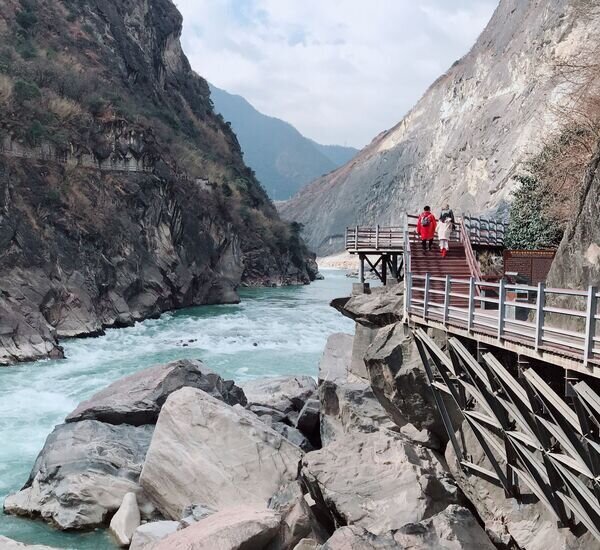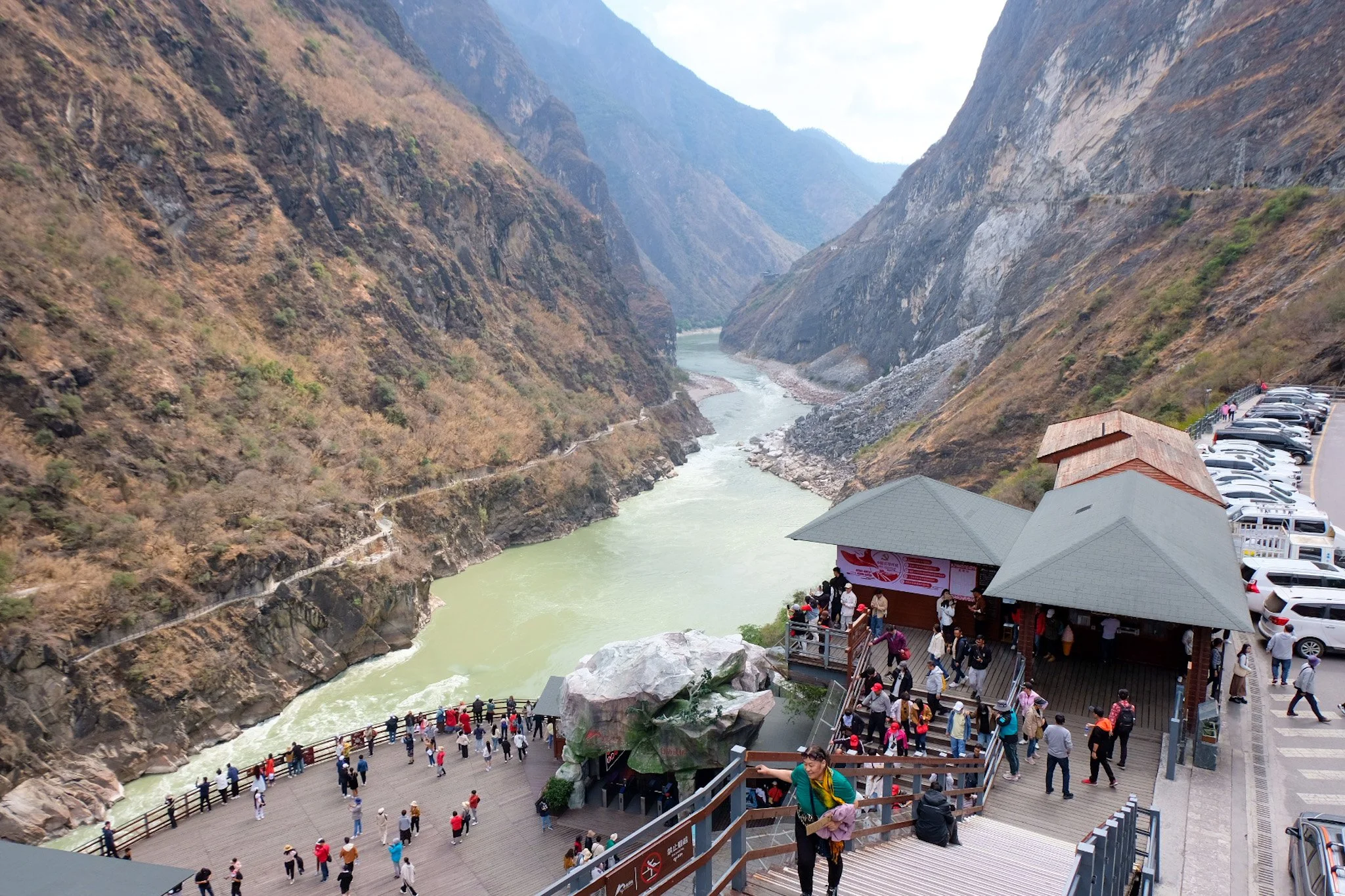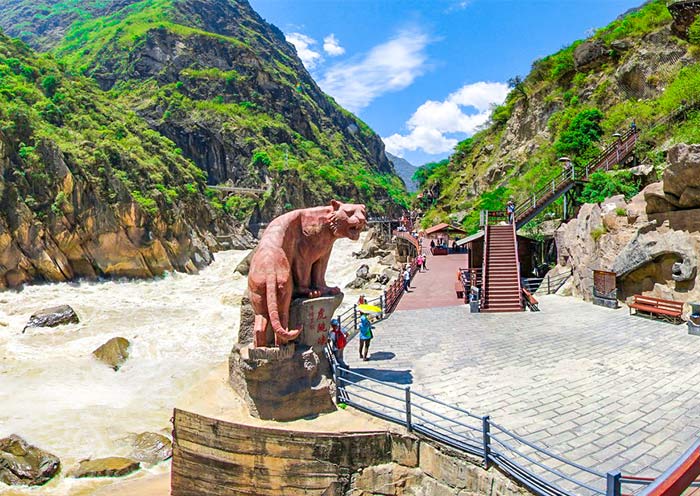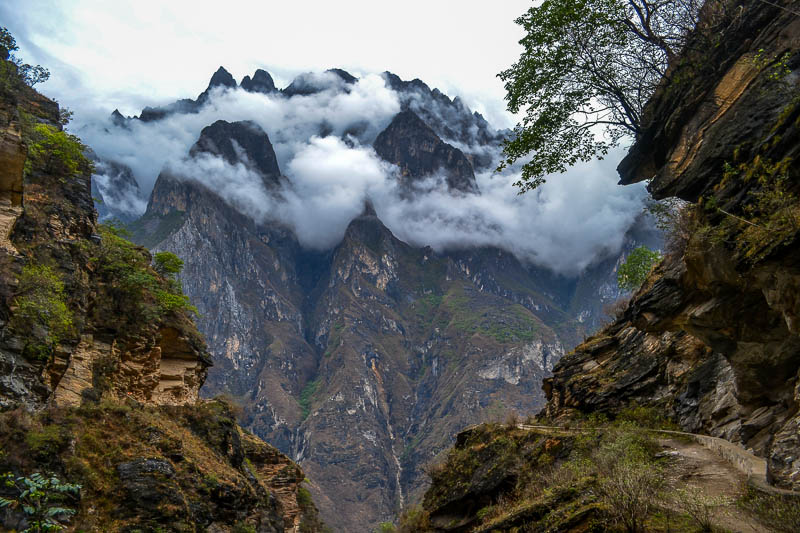Unveiling the Legends: The Myth Behind Tiger Leaping Gorge
An Essential Guide to Visiting Tiger Leaping Gorge
Nestled in the breathtaking Yunnan Province of China, Tiger Leaping Gorge (虎跳峡) stands as one of the world’s most awe-inspiring natural wonders. Imagine towering cliffs that plunge dramatically into a raging river, with jade-green waters carving their way through a canyon deeper than the Grand Canyon itself. This enchanting landscape is not just a feast for the eyes; it’s a legendary site steeped in folklore, where a daring tiger is said to have leaped across the gorge to escape its pursuers. The sheer beauty and cultural richness of Tiger Leaping Gorge attract adventurers and nature lovers from around the globe, making it a must-visit destination.
In this essential guide, we’ll walk you through everything you need to know to make the most of your visit. From the best times to hike and how to get there, to detailed itineraries for multi-day treks and recommendations for local accommodations, we’ve compiled all the vital information to ensure that your journey through this magnificent gorge is unforgettable. Whether you’re seeking thrilling hikes, stunning scenery, or a glimpse into the vibrant local culture, Tiger Leaping Gorge promises an experience unlike any other. So lace up your hiking boots and get ready to explore one of China’s greatest treasures!
In This Guide
- An Essential Guide to Visiting Tiger Leaping Gorge
- The Rich History and Legends of Tiger Leaping Gorge
- Main Highlights: What You Absolutely Can’t Miss
- Planning Your Visit: A Practical Guide
- Tickets: Prices, Booking, and Tips
- How to Get There: A Complete Transportation Guide
- Local Cuisine and Accommodation Nearby
- Frequently Asked Questions
- Final Thoughts on Your Trip
The Rich History and Legends of Tiger Leaping Gorge
Tiger Leaping Gorge, tucked away in the magnificent Yunnan Province of China, is not only a natural wonder but also a site steeped in rich history and folklore. This breathtaking gorge is defined by its dramatic landscapes and cultural significance, making it a must-visit destination for international travelers.
Ancient Origins and Cultural Significance
The history of Tiger Leaping Gorge dates back thousands of years, intertwined with the lives of the indigenous people who have called this area home. The gorge has long been inhabited by various ethnic groups, including the Naxi, Bai, and Tibetan communities, each bringing their own unique customs, traditions, and stories. The Naxi people, in particular, have preserved many of their ancient traditions and beliefs, which are deeply rooted in the natural world around them.
Historically, this region served as a crucial transit route for trade and cultural exchanges between Tibet and the lowland regions of China. The gorge’s strategic location facilitated interactions among diverse cultures, contributing to the rich tapestry of traditions that can still be seen today.
The Legend of the Tiger
One of the most captivating legends associated with Tiger Leaping Gorge involves a daring tiger that eluded its pursuers in a dramatic leap across the narrowest point of the gorge. According to local lore, the tiger, hunted by poachers, made a desperate escape by leaping from one side of the Jinsha River to the other, using a large rock as a springboard. This legendary jump, estimated to be about 25 meters (82 feet), has given the gorge its name and symbolizes the spirit of resilience and survival.
The story of the tiger continues to be a source of inspiration for local artists and storytellers, reinforcing the connection between the natural landscape and the cultural identity of the region. It serves as a reminder of the fierce beauty of nature and the enduring legends that shape the lives of those who inhabit it.
Natural Wonders and Historical Events
Tiger Leaping Gorge is not only a site of legends but also a geological marvel. Carved by the powerful Jinsha River, which is a tributary of the Yangtze River, it stands as one of the deepest river canyons in the world. The gorge reaches depths of over 3,790 meters (12,434 feet) from its peaks down to the river below, dwarfing even the Grand Canyon.
The area was relatively undiscovered by foreign tourists until 1993, although local communities have welcomed visitors since the early 1980s. This gradual increase in tourism has sparked interest in the region’s natural beauty and cultural heritage, leading to efforts to preserve the environment and local traditions.
A Modern Perspective
Today, Tiger Leaping Gorge is recognized as one of the best hiking destinations in China, attracting adventurers from around the globe. The gorge’s stunning vistas, with snow-capped peaks of the Jade Dragon and Haba Mountains flanking the turquoise waters of the Jinsha River, provide a breathtaking backdrop for trekkers and nature enthusiasts.
Visitors can engage with the rich history of the gorge through guided tours, local storytelling, and cultural performances. The continued presence of the Naxi people, along with their traditions and crafts, offers a glimpse into the past and a connection to the land that has shaped their lives for generations.
Conclusion
As you embark on your journey through Tiger Leaping Gorge, take the time to appreciate not just the stunning landscapes but also the rich history and legends that define this extraordinary place. From the tales of the legendary tiger to the enduring traditions of the local communities, Tiger Leaping Gorge is a testament to the intertwined nature of culture and nature, inviting all who visit to explore its depths and discover its stories.

Tiger Leaping Gorge.
Main Highlights: What You Absolutely Can’t Miss
The Legendary Jumping Tiger Rock
At the very heart of the legend that gives Tiger Leaping Gorge its name lies the awe-inspiring Jumping Tiger Rock. This colossal stone, positioned at the narrowest point of the gorge, is said to be the spot where a tiger made its daring escape from hunters by leaping across the Jinsha River. Standing here, you can feel the thrill of the tale wash over you as you gaze down into the roaring waters below. It’s an ideal photo opportunity, so be ready to capture the moment!
Practical Tip: Arrive early in the morning to avoid the crowds and savor the tranquility of the gorge. The best views are during the early hours when the light dances on the water.
The 28 Bends
Prepare yourself for one of the most challenging and rewarding sections of your hike: the famous 28 Bends. This steep and winding path ascends approximately 9000 feet, offering breathtaking views of the gorge and the surrounding mountains. The zigzagging trail is demanding but the scenery that unfolds with every turn will leave you breathless—both from the climb and the panorama!
Practical Tip: Pace yourself! Take breaks to catch your breath and enjoy the views. Be sure to carry enough water and snacks, as this section can take about 45-60 minutes to complete.
Naxi Guesthouse
Nestled amidst the rugged landscape, the Naxi Guesthouse serves as a welcoming pit stop for weary hikers. Here, you can rest your legs, refill your water bottles, and indulge in a hearty meal featuring local Naxi cuisine. The atmosphere is warm and friendly, providing a glimpse into the culture of the Naxi people who have inhabited the gorge for generations.
Practical Tip: Sample the local dishes, like the Naxi-style noodles, and chat with the guesthouse staff to learn more about the culture and traditions of the area.
Tea Horse Guesthouse
As you make your way along the trail, the Tea Horse Guesthouse is another excellent place to stop for the night. This charming spot offers cozy accommodations and stunning views of the gorge and the Jade Dragon Snow Mountain. After a long day of hiking, relax on the terrace with a cup of local tea and let the beauty of your surroundings wash over you.
Practical Tip: Book your stay in advance, especially during peak hiking seasons, to ensure you have a spot. The guesthouse often fills up quickly due to its popularity among trekkers.
The Jade Dragon Snow Mountain Viewpoint
No hike through Tiger Leaping Gorge would be complete without a visit to the Jade Dragon Snow Mountain viewpoint. This breathtaking vantage point allows you to capture the dramatic contrast between the snow-capped peaks and the lush greenery of the gorge. It’s a photographer’s paradise, and the views are simply unforgettable.
Practical Tip: Bring a good camera and be prepared for changing weather conditions. The best time for photos is during the early morning when the sun casts a golden glow on the mountains.
The Jinsha River
The heart and soul of Tiger Leaping Gorge, the Jinsha River, is a sight to behold. As it flows fiercely through the gorge, the river showcases the raw power of nature. Take a moment to sit by the riverbank and listen to the rush of the water, allowing yourself to be mesmerized by its beauty.
Practical Tip: Wear sturdy shoes if you decide to explore along the riverbanks, and be cautious of slippery rocks and fast currents. This is a great spot for a picnic if you have packed a lunch!
The Scenic Overlook at Haba Snow Mountain
As you trek along the gorge, be sure to take the time to stop at the scenic overlook for Haba Snow Mountain. This less-frequented viewpoint offers some of the best panoramic views in the gorge. The striking contrast between the rugged cliffs and the serene beauty of the mountain makes for an unforgettable experience.
Practical Tip: This spot is perfect for sunset viewing. Bring a light jacket as temperatures can drop in the evening, and don’t forget to capture the stunning colors as the sun sets behind the mountains.

Tiger Leaping Gorge.
Planning Your Visit: A Practical Guide
Best Time to Visit
Tiger Leaping Gorge is best explored during the dry months of April, May, August, September, and October. These periods offer pleasant weather with minimal rainfall, making them ideal for hiking. The spring and autumn months bring vibrant landscapes, while the summer season allows for lush greenery, though you might encounter occasional rain. If you’re aiming for fewer crowds, consider visiting during the shoulder seasons of late April or early October.
Recommended Itinerary
To truly savor the breathtaking scenery and cultural diversity of Tiger Leaping Gorge, plan for at least two to three days of hiking. Here’s a suggested itinerary:
Day 1: Qiaotou to Tea Horse Guesthouse
- Distance: 15 km (approx. 6-8 hours)
- Highlights: Start your trek at Qiaotou, tackling the steep inclines and the famed 28 bends. Enjoy a well-deserved rest at the Naxi Guesthouse for lunch before continuing to the Tea Horse Guesthouse for an overnight stay.
Day 2: Tea Horse Guesthouse to Halfway Guesthouse
- Distance: 10-12 km (approx. 5-6 hours)
- Highlights: Experience stunning views of the Jade Dragon Snow Mountain and follow the trail along the gorge. Arrive at Halfway Guesthouse and enjoy a sunset view.
Day 3: Halfway Guesthouse to Qiaotou
- Distance: 12-15 km (approx. 4-5 hours)
- Highlights: Return to Qiaotou, soaking in the scenery one last time. You can choose to extend your hike or explore nearby villages.
Photography Tips
The majestic landscapes of Tiger Leaping Gorge provide countless opportunities for stunning photography. Here are some tips to help you capture the beauty:
- Golden Hours: Shoot during sunrise or sunset for the best lighting. The warm hues will enhance the rugged mountains and vibrant river.
- Wide-Angle Lens: Bring a wide-angle lens to capture the expansive views of the gorge and mountains.
- Foreground Interest: Incorporate elements like flowers, rocks, or local architecture to add depth to your photos.
- Respect Nature: Avoid disturbing wildlife and adhere to any guidelines to preserve the natural beauty.
What to Wear
Dressing appropriately for your hike is critical for comfort and safety:
- Footwear: Invest in sturdy, waterproof hiking boots with good grip, as the trails can be steep and rocky.
- Layers: Wear moisture-wicking base layers with insulating layers to adjust to temperature changes throughout the day.
- Rain Gear: Pack a lightweight rain jacket or poncho, especially if you’re hiking in the spring or summer months.
- Sun Protection: Sunglasses, a wide-brimmed hat, and sunscreen are essential for protection against UV rays at higher altitudes.
Insider Tips
-
Stay Hydrated: Carry a reusable water bottle and refill it at guesthouses along the trail. Staying hydrated is crucial for maintaining your energy levels.
-
Local Cuisine: Try the local Naxi dishes at guesthouses, such as stir-fried yak meat or mushroom soup, to fuel your hike and experience the culture.
-
Pack Light: Only bring essentials and leave heavy items behind. Most guesthouses offer luggage storage, allowing you to hike freely.
-
Learn Basic Mandarin: Knowing a few phrases can enhance your interactions with locals. Simple greetings and thank-yous go a long way!
-
Respect Local Customs: Be mindful of the local culture and traditions, especially in areas inhabited by the Naxi people. Engaging respectfully can lead to a more enriching experience.
Embrace the adventure and beauty of Tiger Leaping Gorge, and prepare for a journey that will leave you with unforgettable memories!

Tiger Leaping Gorge.
Tickets: Prices, Booking, and Tips
When planning your adventure to Tiger Leaping Gorge, understanding the ticketing process is essential for a smooth experience. Below is a handy table summarizing the ticket types, prices, and what’s included:
| Ticket Type | Price (CNY) | Includes |
|---|---|---|
| Entrance Ticket | 65 | Access to the scenic area |
| Shuttle Bus Ticket | 24 | Bus transport from Lijiang to Qiaotou |
| Luggage Storage | 5 | Secure storage for bags at guesthouses |
Booking Information
Tickets for Tiger Leaping Gorge can be purchased on-site upon arrival. However, to ensure you don’t miss out on your hike, especially during peak seasons, it’s advisable to book in advance. Many travelers prefer to arrange their transportation and tickets through local guesthouses in Lijiang, which can simplify the process.
-
Book Accommodation: Secure a stay at guesthouses such as Jane’s Tibetan Guesthouse or Tea Horse Guesthouse, which often assist with ticket bookings and transportation.
-
Transportation: The most convenient way to reach the gorge is by taking a shuttle bus or regular bus from Lijiang. The shuttle bus may have limited seats, so it’s wise to reserve your spot the day before your hike.
-
On Arrival: Once you arrive at Qiaotou, you will purchase your entrance ticket directly from the Tiger Leaping Gorge tourist office, where an attendant will assist you.
By planning ahead and booking your tickets in advance, you can focus on enjoying the breathtaking views and the exhilarating hike rather than worrying about logistics. Happy hiking!
How to Get There: A Complete Transportation Guide
Getting to Tiger Leaping Gorge: A Comprehensive Transportation Guide
Visiting Tiger Leaping Gorge is an adventure that begins with getting there. Whether you’re arriving from bustling cities or tranquil towns, this guide will help you navigate your way to one of China’s most stunning natural wonders.
From the Nearest Major City
Lijiang
Lijiang is the most common gateway to Tiger Leaping Gorge, making it an ideal starting point for international travelers.
- By Train:
- Sleeper Train: If you’re coming from cities like Beijing, Shanghai, or Kunming, consider taking a sleeper train to Lijiang. This option allows you to experience a unique aspect of Chinese travel while enjoying a comfortable overnight journey.
-
Bullet Train: Travelers already within Yunnan Province can opt for a bullet train to Lijiang for a quicker and more efficient ride.
-
By Bus:
- Once in Lijiang, head to the Lijiang Bus Station. Purchase a ticket for the number 13 bus, which departs at 8:30 AM and costs approximately 24 Yuan (less than $4). To ensure a seat, it’s advisable to buy your ticket the day before.
- Alternatively, some guesthouses offer shuttle services, like one that departs at 7:15 AM for about 40 Yuan, providing an easier and more direct route to the gorge.
Shangri-La
If you’re in Shangri-La, you can also reach Tiger Leaping Gorge, albeit with fewer direct connections.
- By Bus:
- Buses from Shangri-La to Qiaotou (the starting point of the hike) take about 2.5 hours. Ensure you check the local bus schedule as services may vary.
Directly to Qiaotou
Regardless of your starting point, all routes will eventually lead you to Qiaotou, the main gateway to Tiger Leaping Gorge. The bus ride from Lijiang or Shangri-La will typically include a brief stop for refreshments and restroom breaks.
Upon arriving at Qiaotou, an attendant from the Tiger Leaping Gorge tourist office will board the bus to sell tickets for entry, which costs around 65 Yuan (approximately $10). After purchasing your entry ticket, the bus will continue to Jane’s Tibetan Guesthouse, where you can grab a map and store any extra luggage for a small fee.
Getting Around the Scenic Area
Once you arrive at the gorge, navigating your way becomes part of the adventure.
- Starting the Hike:
-
From Jane’s Guesthouse, turn left and follow the dusty road. You’ll pass a school and then encounter a fork in the road; take the uphill path to the left. Look for blue signs pointing towards the upper gorge.
-
Hiking Trails:
-
The Upper Route is the most popular hiking trail. It typically takes 2-3 days to complete, with accommodations available at various guesthouses along the route. Make sure you have a map, available at the guesthouse, to help guide you along the trail.
-
Returning to Lijiang:
- After completing your hike, you’ll need to return to Lijiang. Ensure you ask your return driver to stop at Tina’s Guesthouse if you plan to collect your luggage there.
Additional Tips
- Timing:
-
The best months to visit Tiger Leaping Gorge are April, May, and the months of August through October, when weather conditions are generally drier.
-
Cash:
- It’s advisable to carry cash, as many smaller guesthouses and vendors may not accept credit cards.
With these transportation options and tips, you are well on your way to experiencing the breathtaking beauty of Tiger Leaping Gorge. Whether traveling from Lijiang, Shangri-La, or beyond, the journey promises to be just as memorable as the destination itself. Happy hiking!

Tiger Leaping Gorge.
Local Cuisine and Accommodation Nearby
Tiger Leaping Gorge is not just about breathtaking landscapes and exhilarating hikes; it’s also an opportunity to savor the rich, local cuisine and find accommodation that suits your style. As you prepare for your adventure, here are some must-try dishes and accommodation options nearby.
Local Cuisine
When exploring the area, don’t miss out on these delectable local dishes:
-
Naxi Treats: The Naxi people, indigenous to the region, offer unique culinary delights. Be sure to try Naxi grilled fish, often seasoned with local herbs and grilled over an open flame. This dish perfectly captures the flavors of the region and is often served with spicy dipping sauces.
-
Yunnan Rice Noodles (Over-the-Bridge Noodles): A quintessential Yunnan dish, these rice noodles are served with a rich broth and a selection of fresh ingredients such as vegetables, meat, and herbs. The broth is often poured over the noodles at your table, allowing you to enjoy the dish piping hot.
-
Wild Mushroom Hot Pot: Yunnan is famous for its diverse mushroom varieties. Experience the local flavors with a hearty wild mushroom hot pot, featuring an array of mushrooms simmered in a savory broth. It’s a perfect dish for sharing with fellow hikers after a long day on the trails.
-
Tea Eggs: A popular snack throughout China, these hard-boiled eggs are simmered in a mixture of tea, soy sauce, and spices. The result is a flavor-packed treat that makes for a great pick-me-up during your hiking adventures.
Accommodation Options
Whether you’re seeking a luxurious retreat or a budget-friendly stay, there are plenty of accommodation options near Tiger Leaping Gorge:
-
Luxury: The Jade Dragon Snow Mountain Resort offers a high-end experience with stunning views of the mountains and gorge. Guests can enjoy spacious rooms, fine dining, and spa services. It’s a perfect place to relax and rejuvenate after a day of hiking.
-
Boutique: Tina’s Guesthouse is a charming spot that embodies local culture and hospitality. With beautifully decorated rooms and a cozy atmosphere, this guesthouse is known for its warm service and delicious meals. It’s an ideal place to meet fellow travelers and share stories of your hiking adventures.
-
Budget: Jane’s Tibetan Guesthouse provides affordable accommodation without sacrificing comfort. Located conveniently near the trailhead, it offers dormitory-style and private rooms. The guesthouse features a communal area where you can relax and refuel with local dishes after a day on the trail.
-
Hostel: For those on a tighter budget, The Tea Horse Guesthouse is a great option. This hostel offers dormitory beds and a friendly vibe, perfect for meeting fellow hikers. The on-site restaurant serves hearty meals to fuel your adventures.
As you embark on your journey through Tiger Leaping Gorge, savor these local flavors and choose an accommodation that makes your stay comfortable and memorable. Enjoy the breathtaking views, rich culture, and delightful cuisine that this extraordinary region has to offer!

Tiger Leaping Gorge.
Frequently Asked Questions
Frequently Asked Questions about Tiger Leaping Gorge
1. Is Tiger Leaping Gorge suitable for children and the elderly?
While Tiger Leaping Gorge is an incredible hiking destination, it may not be suitable for very young children or elderly individuals who have mobility issues. The trails can be steep and challenging, especially in certain sections like the infamous 28 bends. However, if you have older children or elderly family members in good physical condition, they may enjoy shorter, easier walks along the gorge with proper supervision and pacing.
2. Are there English signs along the trails?
Yes, many of the trails in Tiger Leaping Gorge are marked with English signs, especially in the more tourist-frequented areas. Additionally, maps are available at guesthouses and tourist offices, making navigation easier for international travelers. However, it’s always a good idea to download a hiking map or have a guidebook handy to ensure you stay on track.
3. How much time should I plan for hiking Tiger Leaping Gorge?
Most hikers plan for at least two days to complete the upper trail, which allows ample time to enjoy the stunning scenery and take breaks. The hike typically takes around 6-8 hours on the first day and 4-6 hours on the second, depending on your pace and how often you stop to enjoy the views. If you want to take your time and explore more of the area, consider extending your trip to three days.
4. What is the best time to visit Tiger Leaping Gorge?
The best months to hike Tiger Leaping Gorge are typically April to May and August to October, when the weather is drier and more pleasant for outdoor activities. During these months, you’ll enjoy clearer skies and stunning views of the mountains. Be sure to check the local weather forecast before you go, as conditions can change rapidly.
5. What should I bring along for the hike?
It’s essential to pack accordingly for your hike. Bring comfortable hiking shoes, a hat, sunscreen, plenty of water, snacks, and a lightweight rain jacket just in case. A small daypack for your essentials will make your hike more enjoyable. If you plan to stay overnight, don’t forget a change of clothes and toiletries.
6. Can I find accommodation along the trail?
Yes, there are several guesthouses along the trail where you can stay overnight. Some popular options include Naxi Guesthouse and Tea Horse Guesthouse. It’s advisable to book your accommodation in advance, especially during peak season, to ensure you have a place to rest after a long day of hiking.
7. How do I get to Tiger Leaping Gorge?
Tiger Leaping Gorge is accessible from Lijiang or Shangri-La. From Lijiang, you can take a bus from the local bus station directly to Qiaotou, the starting point for the hike. The bus ride takes about 2.5 hours. Alternatively, consider taking a shuttle from your guesthouse for a more convenient option. Ensure you inform the driver to drop you off at Qiaotou.
8. Is there a fee to enter Tiger Leaping Gorge?
Yes, there is an entrance fee to access Tiger Leaping Gorge. As of now, the fee is around 65 Yuan (approximately $10 USD). You can purchase your ticket at the tourist office after you arrive at Qiaotou, and it is usually collected by an attendant on the bus. Keep your ticket handy, as it may be checked along the trail.
Final Thoughts on Your Trip
As your adventure at Tiger Leaping Gorge comes to a close, take a moment to reflect on the breathtaking beauty and the profound experiences you’ve encountered along the trail. From the majestic peaks of the Jade Dragon Snow Mountain to the roaring Jinsha River below, each step has been a reminder of nature’s grandeur and the vibrant culture surrounding this remarkable landscape.
Whether you tackled the challenging 28 bends or found peace in the tranquil vistas, the essence of Tiger Leaping Gorge lies in its ability to inspire awe and introspection. The stories of the local Naxi people and the legends of the tiger leaping across the gorge add layers of depth to your journey, making it not just a hike but a connection with the heart of Yunnan.
As you return from this adventure, carry with you the memories of the stunning views, the camaraderie with fellow hikers, and the sense of accomplishment that comes from embracing the wild. Tiger Leaping Gorge isn’t just a destination; it’s an invitation to explore, to challenge yourself, and to discover the beauty that lies in both the journey and the destination. So, lace up your boots and keep seeking out those majestic trails—who knows what other wonders await you in the world? Safe travels!